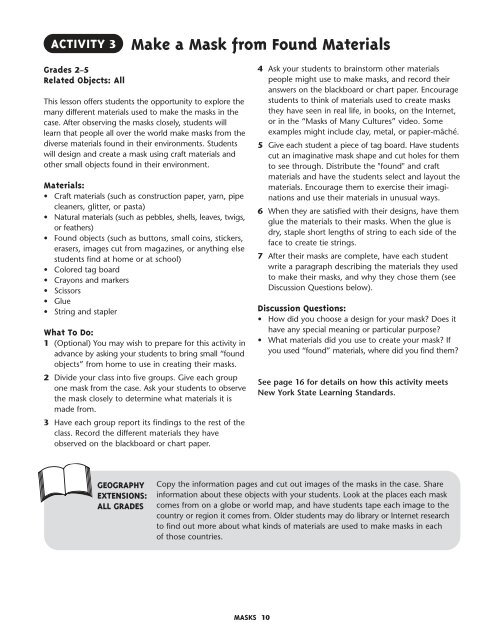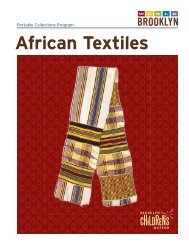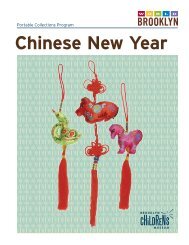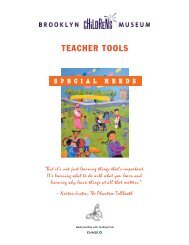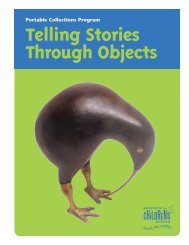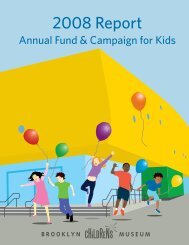What Are Masks For? - Brooklyn Children's Museum
What Are Masks For? - Brooklyn Children's Museum
What Are Masks For? - Brooklyn Children's Museum
Create successful ePaper yourself
Turn your PDF publications into a flip-book with our unique Google optimized e-Paper software.
ACTIVITY 3<br />
Make a Mask from Found Materials<br />
Grades 2–5<br />
Related Objects: All<br />
This lesson offers students the opportunity to explore the<br />
many different materials used to make the masks in the<br />
case. After observing the masks closely, students will<br />
learn that people all over the world make masks from the<br />
diverse materials found in their environments. Students<br />
will design and create a mask using craft materials and<br />
other small objects found in their environment.<br />
Materials:<br />
• Craft materials (such as construction paper, yarn, pipe<br />
cleaners, glitter, or pasta)<br />
• Natural materials (such as pebbles, shells, leaves, twigs,<br />
or feathers)<br />
• Found objects (such as buttons, small coins, stickers,<br />
erasers, images cut from magazines, or anything else<br />
students find at home or at school)<br />
• Colored tag board<br />
• Crayons and markers<br />
• Scissors<br />
• Glue<br />
• String and stapler<br />
<strong>What</strong> To Do:<br />
1 (Optional) You may wish to prepare for this activity in<br />
advance by asking your students to bring small “found<br />
objects” from home to use in creating their masks.<br />
2 Divide your class into five groups. Give each group<br />
one mask from the case. Ask your students to observe<br />
the mask closely to determine what materials it is<br />
made from.<br />
3 Have each group report its findings to the rest of the<br />
class. Record the different materials they have<br />
observed on the blackboard or chart paper.<br />
4 Ask your students to brainstorm other materials<br />
people might use to make masks, and record their<br />
answers on the blackboard or chart paper. Encourage<br />
students to think of materials used to create masks<br />
they have seen in real life, in books, on the Internet,<br />
or in the “<strong>Masks</strong> of Many Cultures” video. Some<br />
examples might include clay, metal, or papier-mâché.<br />
5 Give each student a piece of tag board. Have students<br />
cut an imaginative mask shape and cut holes for them<br />
to see through. Distribute the "found" and craft<br />
materials and have the students select and layout the<br />
materials. Encourage them to exercise their imaginations<br />
and use their materials in unusual ways.<br />
6 When they are satisfied with their designs, have them<br />
glue the materials to their masks. When the glue is<br />
dry, staple short lengths of string to each side of the<br />
face to create tie strings.<br />
7 After their masks are complete, have each student<br />
write a paragraph describing the materials they used<br />
to make their masks, and why they chose them (see<br />
Discussion Questions below).<br />
Discussion Questions:<br />
• How did you choose a design for your mask? Does it<br />
have any special meaning or particular purpose?<br />
• <strong>What</strong> materials did you use to create your mask? If<br />
you used “found” materials, where did you find them?<br />
See page 16 for details on how this activity meets<br />
New York State Learning Standards.<br />
GEOGRAPHY<br />
EXTENSIONS:<br />
ALL GRADES<br />
Copy the information pages and cut out images of the masks in the case. Share<br />
information about these objects with your students. Look at the places each mask<br />
comes from on a globe or world map, and have students tape each image to the<br />
country or region it comes from. Older students may do library or Internet research<br />
to find out more about what kinds of materials are used to make masks in each<br />
of those countries.<br />
MASKS 10


